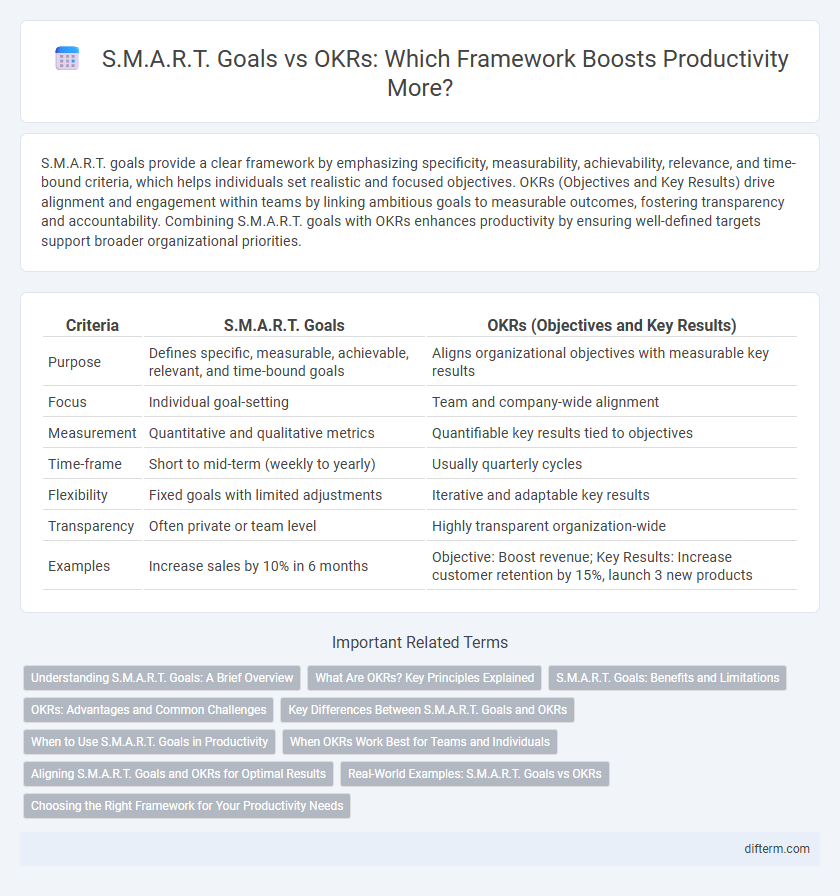S.M.A.R.T. goals provide a clear framework by emphasizing specificity, measurability, achievability, relevance, and time-bound criteria, which helps individuals set realistic and focused objectives. OKRs (Objectives and Key Results) drive alignment and engagement within teams by linking ambitious goals to measurable outcomes, fostering transparency and accountability. Combining S.M.A.R.T. goals with OKRs enhances productivity by ensuring well-defined targets support broader organizational priorities.
Table of Comparison
| Criteria | S.M.A.R.T. Goals | OKRs (Objectives and Key Results) |
|---|---|---|
| Purpose | Defines specific, measurable, achievable, relevant, and time-bound goals | Aligns organizational objectives with measurable key results |
| Focus | Individual goal-setting | Team and company-wide alignment |
| Measurement | Quantitative and qualitative metrics | Quantifiable key results tied to objectives |
| Time-frame | Short to mid-term (weekly to yearly) | Usually quarterly cycles |
| Flexibility | Fixed goals with limited adjustments | Iterative and adaptable key results |
| Transparency | Often private or team level | Highly transparent organization-wide |
| Examples | Increase sales by 10% in 6 months | Objective: Boost revenue; Key Results: Increase customer retention by 15%, launch 3 new products |
Understanding S.M.A.R.T. Goals: A Brief Overview
S.M.A.R.T. goals are specific, measurable, achievable, relevant, and time-bound objectives designed to enhance productivity through clear direction and accountability. This framework helps individuals and teams set precise targets, track progress accurately, and maintain motivation by ensuring each goal is realistic and deadline-driven. Unlike OKRs, which emphasize aspirational objectives and key results, S.M.A.R.T. goals focus on practical execution and detailed planning for consistent performance improvements.
What Are OKRs? Key Principles Explained
OKRs (Objectives and Key Results) are a goal-setting framework designed to align individual and team objectives with measurable outcomes, driving productivity and transparency. Core principles include setting ambitious yet achievable objectives, defining specific key results as quantifiable milestones, and maintaining regular check-ins to track progress and adapt strategies. This method contrasts with S.M.A.R.T. goals by emphasizing organizational alignment and continuous performance evaluation rather than solely focusing on individual task completion.
S.M.A.R.T. Goals: Benefits and Limitations
S.M.A.R.T. goals enhance productivity by providing clear, specific, measurable, achievable, relevant, and time-bound objectives that facilitate focused task management and progress tracking. Their primary benefit lies in improving individual accountability and ensuring realistic milestones that align with personal or team capacity. However, S.M.A.R.T. goals may limit flexibility and innovation due to their structured nature, making them less adaptable to dynamic or complex projects compared to broader goal-setting frameworks like OKRs.
OKRs: Advantages and Common Challenges
OKRs (Objectives and Key Results) enhance productivity by aligning team efforts with measurable, ambitious goals that foster transparency and accountability across organizations. Advantages include improved focus on priorities, real-time progress tracking, and motivation through ambitious yet achievable key results. Common challenges involve balancing ambition with realism, maintaining commitment throughout the cycle, and ensuring alignment without causing goal overload or confusion.
Key Differences Between S.M.A.R.T. Goals and OKRs
S.M.A.R.T. goals emphasize Specific, Measurable, Achievable, Relevant, and Time-bound criteria for setting clear, actionable objectives typically within individual or small team scopes. OKRs (Objectives and Key Results) focus on ambitious, qualitative objectives paired with quantifiable key results to drive alignment and measurable progress across organizations. The primary difference lies in S.M.A.R.T.'s precision for achievable targets versus OKRs' stretch goals designed to inspire innovation and strategic growth.
When to Use S.M.A.R.T. Goals in Productivity
S.M.A.R.T. goals excel in individual productivity contexts where specific, measurable, achievable, relevant, and time-bound targets drive clear task completion. Use S.M.A.R.T. goals for short-term projects or personal development plans requiring focused milestones and precise outcomes. These goals optimize performance tracking and maintain motivation in scenarios demanding detailed progress measurement.
When OKRs Work Best for Teams and Individuals
OKRs work best for teams and individuals in dynamic environments where ambitious, measurable goals drive innovation and alignment. Their flexible structure encourages continuous progress tracking and cross-functional collaboration, enhancing accountability and focus on key results. S.M.A.R.T. goals tend to suit specific, short-term objectives, while OKRs excel in fostering long-term strategic growth and adaptability.
Aligning S.M.A.R.T. Goals and OKRs for Optimal Results
Aligning S.M.A.R.T. goals with OKRs enhances organizational productivity by combining specific, measurable targets with ambitious, outcome-driven objectives. Integrating clear Key Results into S.M.A.R.T. goals ensures consistent progress tracking and strategic focus across teams. This alignment drives accountability while fostering adaptable execution toward optimal business performance.
Real-World Examples: S.M.A.R.T. Goals vs OKRs
S.M.A.R.T. goals focus on setting Specific, Measurable, Achievable, Relevant, and Time-bound objectives, exemplified by a sales team increasing quarterly revenue by 15% through targeted client outreach. OKRs (Objectives and Key Results) emphasize ambitious, qualitative objectives paired with measurable key results, as demonstrated by a tech company aiming to "Improve customer satisfaction" with key results like reducing support response time by 30% and achieving a Net Promoter Score of 50. Real-world applications show S.M.A.R.T. goals provide clarity for short-term, individual performance, while OKRs drive alignment and innovation across entire organizations.
Choosing the Right Framework for Your Productivity Needs
S.M.A.R.T. Goals provide a clear, actionable framework by emphasizing Specific, Measurable, Achievable, Relevant, and Time-bound criteria, ideal for individual task completion and short-term objectives. OKRs (Objectives and Key Results) promote ambitious goal-setting by linking measurable results to broader organizational vision, enhancing alignment and motivation across teams. Selecting between S.M.A.R.T. Goals and OKRs depends on whether the focus is on precise, manageable outcomes or aspirational, scalable achievements that drive continuous performance improvement.
S.M.A.R.T. Goals vs OKRs Infographic

 difterm.com
difterm.com